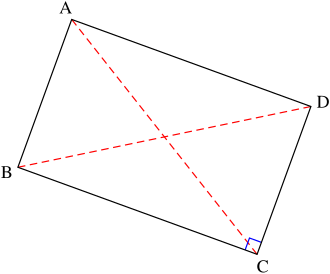AY Honors/Native Brush Construction/Answer Key
1
A house that is "square" is one whose corners form right angles (90°). The house itself can be any type of rectangle or collection of rectangles (it doesn't have to be a square).
To lay out a perfect rectangle, the wall that connects the corners A and B (we'll call that wall AB) must be the same length as the wall that connects corners C and D (which we'll call CD). Further, wall BC must be the same length as AD. But that's just the starting point. Even if all the walls are the proper length, the rectangle can be skewed to form a parallelogram (see illustration)
To correct for this, all we need to do is make sure the diagonals in our rectangle are equal length. The diagonals are the imaginary lines connecting A to C and B to D (that is, AC and BD).
It is best to choose the location of two corners of the house and drive stakes in the ground to mark where they will go. Then take the remaining measurements from these two corners, adjusting the position of the other two corners until the diagonals are equal and the sides are the right length. Then drive these stakes in the ground. Once the stakes have been driven, measure the lines again. If the distances are wrong, start over. If a house is laid out crooked, it will affect every other aspect of its construction, making every job in building it more difficult.
2
3
3
4
See the Thatching honor for detailed instruction.
5
6
7


